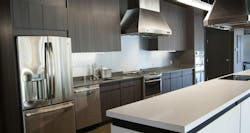4 Common Kitchen Mistakes Pros Should Avoid
Designing a kitchen requires not only an eye for style, but an understanding of principles that ensure functionality and safety.
Some designers are reluctant to tell their clients “no” when they insist on stuffing a home’s most-popular room with too many appliances or placing them where they are likely to cause accidents.
In Part 2 of our series, we checked in with NKBA experts to identify some of the most common design flaws that homeowners, contractors, and even some designers make when they ignore the rules. (See Part 1, featuring common bathroom mistakes, here).
Here are four that stood out:
1. Tight fit
If a homeowner bumps into a kitchen island every time she bends over to load the dishwasher, or if the dishwasher door slams into that island, the appliance simply is too close.
NKBA recommends leaving a minimum of 21 inches of standing space between the edge of the dishwasher and another appliance, cabinets, or anything else that might get in the way of the person using it.
“You need adequate space to load a dishwasher,” says Sherrie Pantalon, CMKBD, owner of Pantalon Design in San Diego. “The same goes for the range.”
2. No room to land
Pantalon’s self-described “pet peeve” is a range with no adjacent counter space on which to place a hot pot or skillet.
“If you pick up a pot,” she says, “you have to cross your body to find somewhere to put it down” if no counter space is within reach. The designer blames the common misplacement on contractors who aren’t cooks and don’t realize the need for a landing area next to the stove.
For ranges, NKBA recommends at least 15 inches of landing area next to or above the oven, or—if the appliance does not open into a walkway—15 inches of landing area that is not more than 4 feet across from the oven.
In addition, NKBA recommends including a section of continuous countertop at least 3 feet wide and 2 feet deep immediately next to a sink as a food prep area. Likewise, designers should include at least 15 inches of landing area on the handle side of a refrigerator, or the same amount of nearby counter space on either side of a side-by-side refrigerator.
3. Overcrowding
The lack of clearances, says designer Cheri Ford-DuBay, CMKBD, often results from the demands of a homeowner who wants to squeeze too many features into a kitchen.
“In order to satisfy a lot of demands from buyers, I think designers just overreach the limits of the spaces by trying to get all the things in and not doing as much education for the homeowner about why things need to be a certain way—for safety reasons or just [functionality],” says Ford-DuBay, a project manager for Indesign in Charlevoix, Mich. She says she has met clients who want three ovens and two dishwashers in a kitchen that simply doesn’t have room for them.
NKBA recommends leaving a distance of no less than 4 feet and no more than 9 feet between each of the three work centers in a kitchen triangle.
“Sometimes, more is more to people, but you can’t always have everything,” Ford-DuBay says. “Being able to prioritize within the design process and really give [the homeowner] a kitchen that’s going to work with as many of the neat functions that they want might not necessarily mean all of them.”
4. Over-range microwave oven
According to designer Annette Starkey, owner of Living Environment Design in Orangevale, Calif., “there are a million things wrong with” mounting a microwave over top of a range.
“That should be outlawed,” she says. “They are extremely dangerous.”
One reason, Starkey explains, is that the cook should be able to see the food that’s heating inside of bowls inside the microwave. Plus, she notes,” When you’re reaching that high and you pull something hot out of the microwave, it is so easy to spill it on yourself. I’m surprised there haven’t been lawsuits for it.”
The ideal location for the bottom of the microwave, NKBA recommends, is 3 inches below the shoulder of the family’s main cook—but no more than 54 inches above the floor. Microwave controls, NKBA says, should be no higher than 46 to 48 inches.
However, NKBA recommends that designers follow manufacturer’s specifications when locating a microwave/hood combination above a cooking surface.
Starkey says many designers simply avoid placing one there. “In 28 years I have never, ever specified an over-the-range” microwave, she says. “Put it anywhere else.”
For more designer insights, check out “5 Common Bathroom Mistakes Pros Should Avoid."
